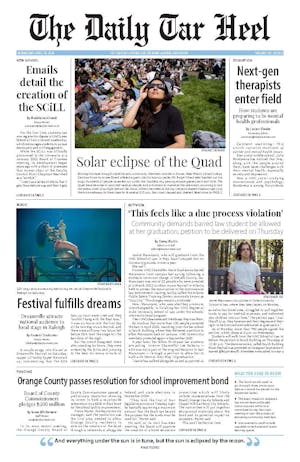“We decided to come together to create a plan for addressing some of the disparate outcomes around the achievement gap and the racial climate that we were seeing increasing in our school district,” said Stephanie Perry, a member of the campaign.
Perry said the organization didn’t feel like the district was listening to them either.
“We were trying to collaborate with the district around our report from the very beginning,” Perry said. “We experienced what we feel to be resistance and pushback. When our report was completed, we had an agreed upon time to present, and it didn’t happen.”
Perry said the campaign presented the issues to other school districts around North Carolina. After doing so, the group finally received an invitation to present at the CHCCS board meeting.
Students think this is just one example of the district failing to discuss racial issues.
“It’s the hugest purple elephant in the room that no one ever wants to talk about,” Clark said.
Monroe Clayton, a senior at Carrboro High School, said he thinks teachers are too scared to openly discuss racial topics, because they’re afraid they might offend someone.
Clayton said forming better relationships between students, administrators and teachers would make discussing racial topics much easier.
“Just something like saying ‘hi’ to students every day makes them feel comforted,” Clayton said. “I think you need to know the students. And that is something, even though it’s so simple, I feel that they regret to do.”
Robin Bulleri, a biology teacher at Carrboro High School, said the district needs to incorporate more community voices into the racial conversation, and on a more regular basis.
“We need to have more regular town hall type meetings with community members and people from the schools,” Bulleri said. “Instead of having meetings when complaints are brought up, there need to be regular meetings.”
Bulleri said she thinks the district needs to eliminate practices that reinforce the disparity between white students and students of color, like tracking.
To get the day's news and headlines in your inbox each morning, sign up for our email newsletters.
Tracking is a system in which students are divided into groups based on their performance in core subjects. Schools begin tracking students early on in their education — generally in middle school — and fill classes with students whose skill levels match one another.
According to Bulleri, CHCCS used to only track math and reading levels. More recently, the district decided to start tracking science and social studies skills as well.
“We told the school board 10 years ago, when they told us they were going to do it, ‘Don’t do it. You’re just going to see segregation of classes,’” Bulleri said. “They did it anyway, and here we are.”
According to the Campaign for Racial Equity’s report, students of color are disproportionately enrolled in standard classes, while honors and Advanced Placement classes are overwhelmingly filled with white students.
Bulleri said to change this, teachers need to take initiative in encouraging students of color to enroll in advanced classes.
“If we see kids in our classes, generally minority students, who might be in a standard level class, and we see them do really well, we need to push them to be in those higher level classes, and then be there to support them as well,” Bulleri said.
Ashanti Heaven, a seventh grader at Culbreth Middle School, said she thinks teachers often unintentionally hurt students of color by singling them out in the classroom.
“If there’s a Hispanic or black student, I feel like teachers think they need more help than other students,” Heaven said. “That’s happened to me before. A teacher thought I needed extra help on math, and that wasn’t the case. I’m actually really good at math.”
Chris Faison, who is the coordinator of Men of Color Engagement in the Center for Student Success and Academic Counseling, said administrators and teachers need to listen to students in order to enact change.
“Let the students lead the teachers and the professionals,” Faison said. “The students are experiencing things on a day-to-day basis that we don’t even know about.”
Faison said if schools truly listen to students’ concerns and involve community organizations, racial inequity can be addressed in a systemic and long-term way.
“It’s the notion of ‘those who are closer to the problem are closer to the solution,’” Faison said. “We have to do a better job of wrapping our arms around the students from a community perspective.”
@mollyjordan0
city@dailytarheel.com


